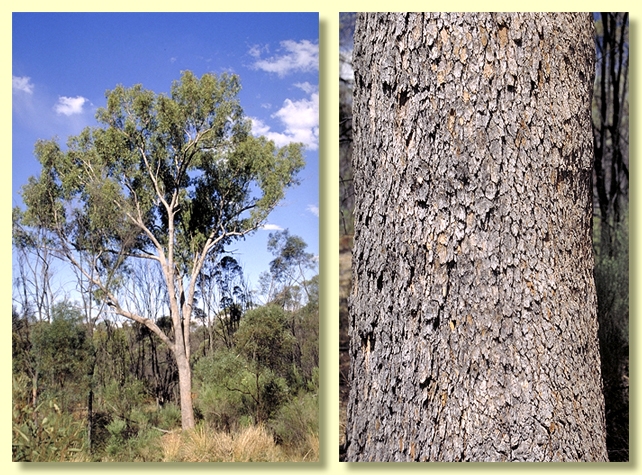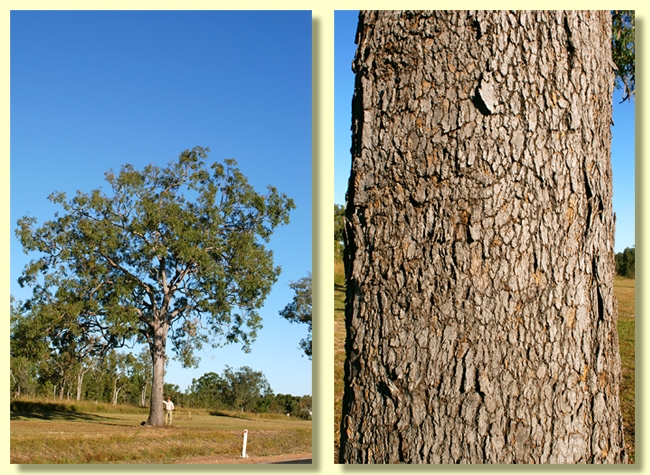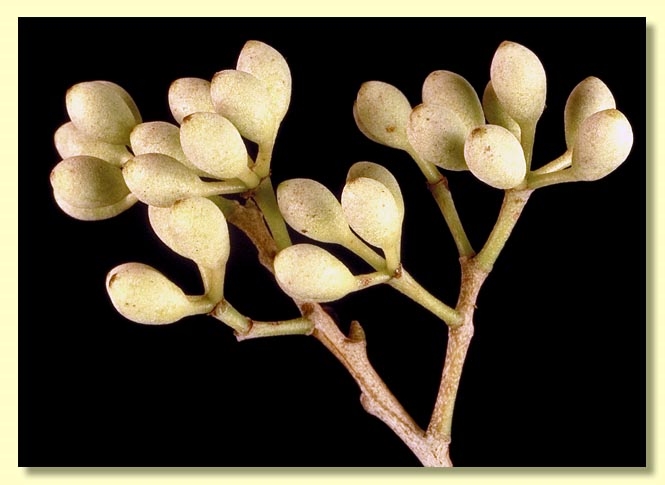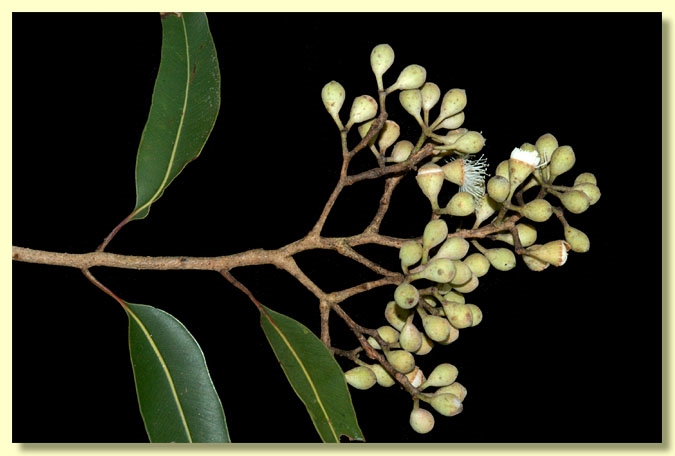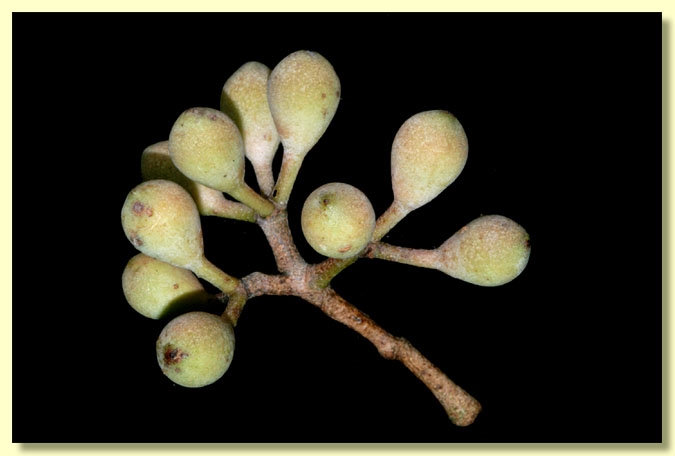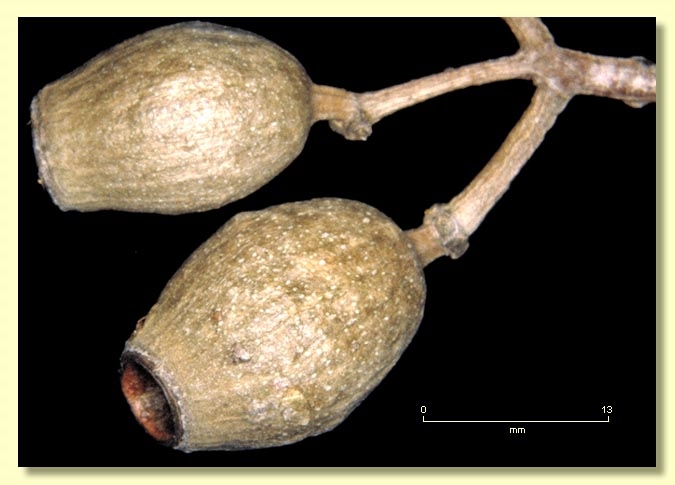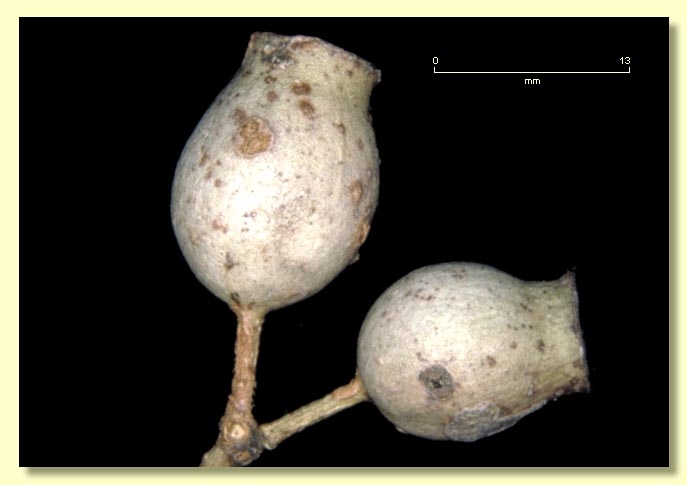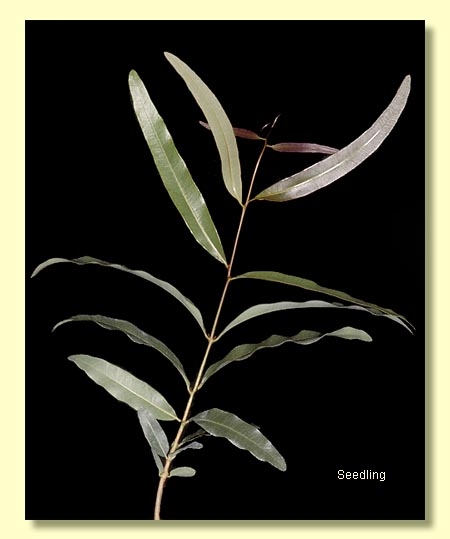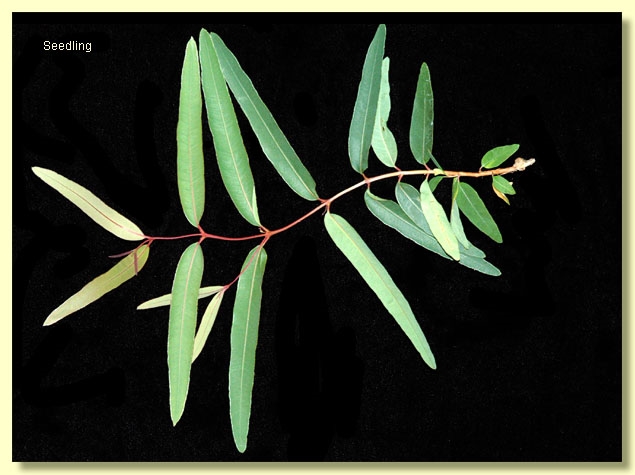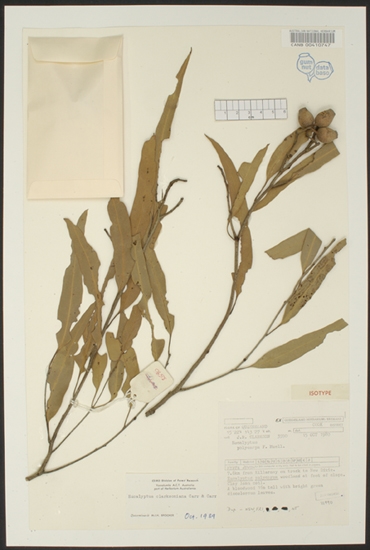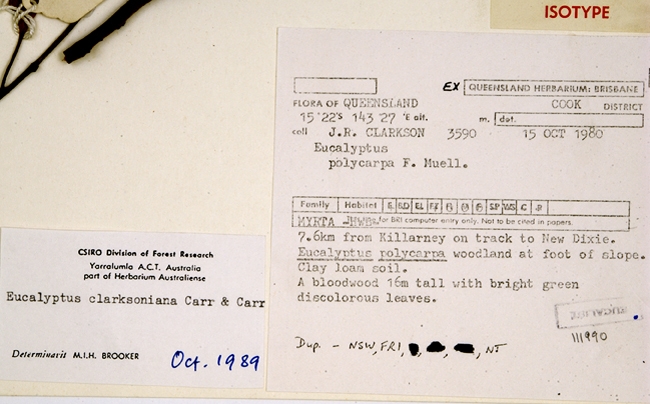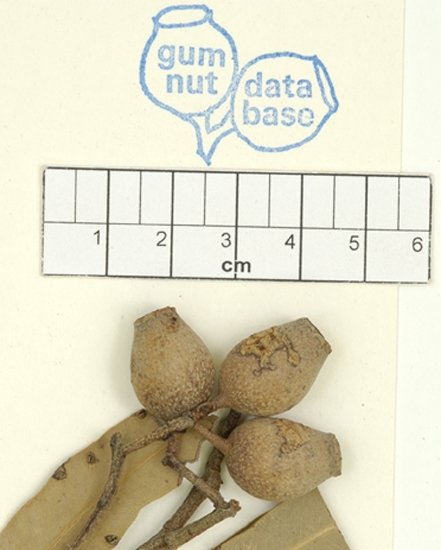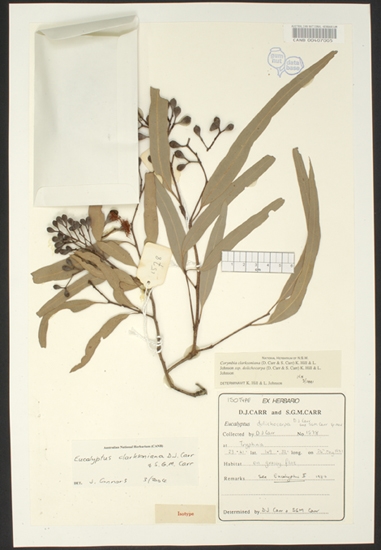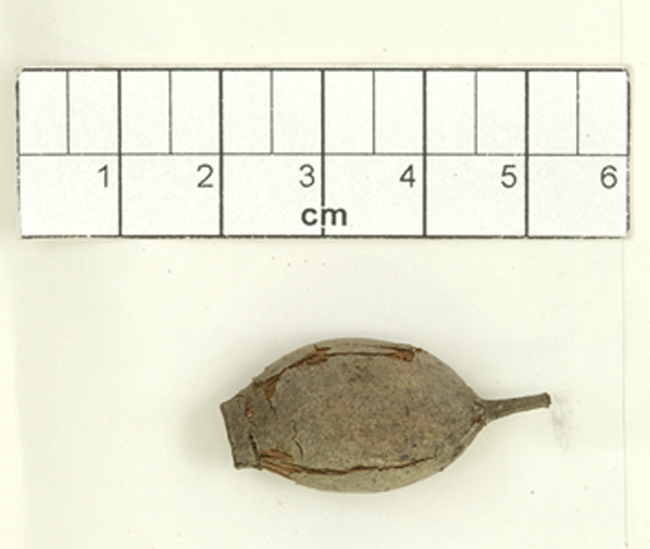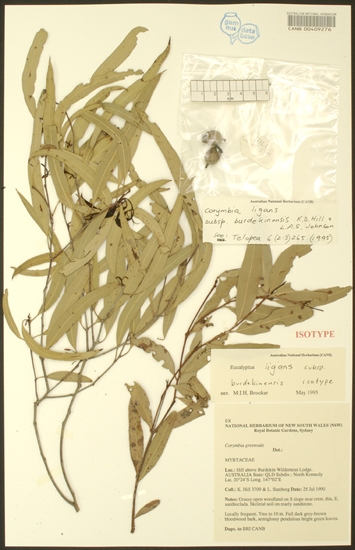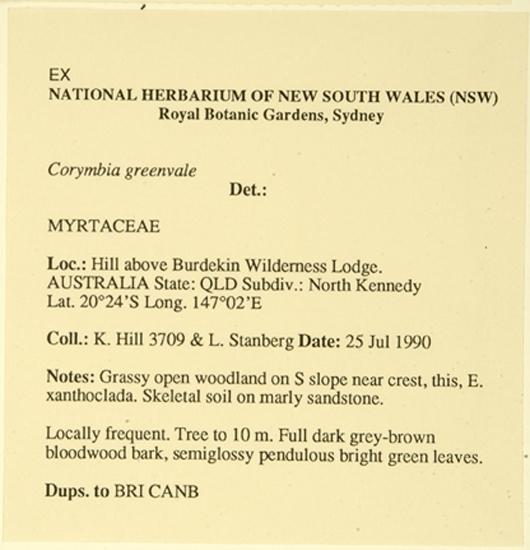Euclid - Online edition
Corymbia clarksoniana
Corymbia | Rufaria
Bark rough throughout, tessellated, grey, grey-brown and red to orange.
Juvenile growth (coppice or field seedlings to 50 cm): stem rounded in cross-section, hairy on early growth; juvenile leaves petiolate, opposite for ca 5 to 12 nodes then becoming alternate, petiolate, narrowly lanceolate to elliptical, 6–14.5 cm long, (0.9)1.2–5 cm wide, base tapering to petiole, discolorous, green, setae present on lower leaves.
Adult leaves alternate, petiole 1–2.2 cm long; blade lanceolate, 6–18 cm long, 1–3 cm wide, base tapering to petiole, discolorous, glossy, green, strongly penniveined, densely to very densely reticulate, intramarginal vein parallel to and just within margin, oil glands island or obscure.
Inflorescence terminal compound, peduncles 0.5–1.7 cm long, buds 7 per umbel, pedicels 0.3–1 cm long. Mature buds obovoid to pyriform, 0.7–1.2 cm long, 0.4–0.8 cm wide, slightly scurfy, scar absent (both opercula shed together at flowering), operculum rounded to conical to beaked, stamens inflexed, anthers cuboid to oblong, versatile, dorsifixed, dehiscing by longitudinal slits (non-confluent), style long, stigma tapered, or mop-like, locules 3 or 4, the placentae each with 3, 5 or indistinct vertical ovule rows. Flowers white.
Fruit pedicellate (pedicels 0.2–1.1 cm long), urceolate varing to barrel-shaped, when barrel-shaped with a slightly flared rim, 1.2–2.5 cm long, 0.9–1.6 cm wide, length always < twice the width, disc descending, valves 3 or 4, enclosed.
Seeds brown or reddish brown, 9–11 mm long, ellipsoidal with terminal wing, dorsal surface smooth, hilum ventral.
Cultivated seedlings (measured at ca node 10): cotyledons reniform to orbicular; stems rounded in cross-section, shortly setose until node 2–8 then smooth; leaves shortly petiolate, opposite for 6 to 13+ nodes then sub-opposite to alternate, narrowly lanceolate to narrowly elliptic-oblong, 7–13 cm long, 1.3–2.5(3.0) cm wide, base tapering, discolorous, slightly glossy or dull, mid-green above; lamina sparsely setose on lower side to node 2–8 then glabrous.
Flowering has been recorded in January, March, April, May, June, July and August.
A medium-sized bloodwood tree occurring on inland plains in the far north of New South Wales and widespread through eastern Queensland north to ca 13° latitude on Cape York Peninsula, as a component of often grassy woodlands and forests on sand and sandy loam, but also may be on rising ground in skeletal soil. Corymbia clarksoniana is recognised by the tessellated bark over the whole trunk, discolorous leaves, terminal inflorescences, slightly scurfy buds, urn-shaped fruit never more than twice as long as wide, and winged seeds. Juvenile leaves are lanceolate-elliptic and setose/scabrid on the lower stem and leaves only.
In Queensland C. clarksoniana is one of a group of five closely related species that are fully rough-barked, have leaves distinctly paler on the underside and have buds at least somewhat scurfy, not entirely smooth. Within this group C. clarksoniana differs from C. polycarpa in having much less scurfy buds and fruit that are urceolate, not narrowly barrel-shaped; C. novoguinensis differs in having plump-pyriform very scurfy buds, urn- to barrel-shaped fruit and prefers well-watered coastal lowlands, being restricted to the monsoonal zone on northern Cape York and the islands of Torres Strait; C. plena, a species of sandy inland areas from Hughenden to Tambo, differs in having ± sub-globular very scurfy buds and thick-rimmed, stoutly urn- to barrel-shaped fruit usually larger than C. clarksoniana (but with some overlap in dimensions), and glabrous juveniles; C. ligans is similar to C. clarksoniana in having scurfy buds, but has narrow adult leaves, smaller and narrower barrel-shaped fruit and occupies rocky, more elevated sites. See table below for fruit comparison.
There are many other more distantly related bloodwoods with discolorous leaves and rough bark that occur throughout the wide range of C. clarksoniana. These are discussed below:
In north-eastern Queensland C. stockeri subsp. stockeri differs in having longer, narrower, glossy, setose juvenile leaves and often smaller fruit (0.8–1.3 cm wide); C. stockeri subsp. peninsularis has smooth-barked branches, non-scurfy buds and fruit and juveniles similar to subsp. stockeri; C. hylandii differs from C. clarksoniana in having narrow glabrous glossy juveniles, non-scurfy buds and smaller fruit; C. nesophila has smooth buds, much smaller fruit (only 0.6–1 cm wide) than C. clarksoniana and ovate-cordate prominently setose juvenile leaves to 2.4–8 cm wide; C. rhodops has smooth buds, flowers with white stamens and a conspicuous red ovary roof, fruit often larger than those of C. clarksoniana, and glossy, glabrous juvenile leaves.
Further to the south C. lamprophylla differs from C. clarksoniana in having smooth buds, very glossy adult leaves, glossy and ± glabrous juvenile leaves and thick-rimmed fruit, whilst C. hendersonii has slightly larger fruit, smooth buds and glabrous juvenile leaves. C. brachycarpa has smooth buds, fruit much the same size as C. clarksoniana but very narrow glabrous juvenile leaves. C. clandestina has smooth buds and fruit smaller than C. clarksoniana and narrow glabrous juvenile leaves.
Closer to the coast C. intermedia differs from C. clarksoniana in having smooth buds, ovoid rather than urn-shaped fruit but similar in size, and at least some peltate juvenile leaves (juveniles never peltate in C. clarksoniana). C. trachyphloia differs in having smaller fruit, wingless seed and juvenile leaves with peltate leaf bases. In southern Queensland and northern New South Wales C. gummifera differs profoundly in having wingless seeds.
In EUCLID C. clarksoniana includes C. doliochocarpa and C. maritima as the differences are slight. C. ligans subsp. burdekinensis we also regard as synonymous with C. clarksoniana, with which it completely overlaps in fruit shape and dimensions and almost completely overlaps in adult leaf dimensions, although the juvenile leaves are a bit smaller in subsp. burdekinensis (but again with some overlap).
This table shows that fruit shape rather than dimensions is the best guide to these four related species:
Species
Fruit shape
Fruit length cm
Fruit width cm
Length: width ratio
clarksoniana
urn-shaped
1.2-2.5
0.9-1.6
1.1 to 1.8
ligans
elongated barrel-shaped, tapering distally, sometimes slightly constricted below the rim
1.1-2
0.7-1.2
1.4 to 1.9
novoguinensis
urn-shaped to barrel-shaped, contracted slightly in upper part with the rim slightly flared
1.7-2.4(3)
1.1-1.5(2)
1.3 to 1.7
polycarpa
elongated barrel-shaped
1.5–3.5
0.8-1.6
1.6 to 2.1
MORE ABOUT CORYMBIA
MORE ABOUT RED BLOODWOODS
John Clarkson began the first five years of his working life in Australia with the Agricultural Branch of the Queensland Department of Primary Industries in Brisbane. In 1974 he joined the Queensland Herbarium as a technician. He studied at night and graduated from the University of Queensland in 1977. In 1979 he was transferred to Mareeba on the Atherton Tablelands in far north Queensland. He has developed a keen knowledge of the plants of this area and is a prolific botanical collector, with many of his collections new to science. He is currently working with the Queensland Parks and Wildlife Service, based in Mareeba.

